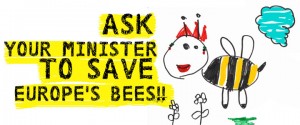What do neonicotinoids have in common with GM potatoes?

There will be no life as we know it without Bees…
We all know that bees are fundamental to our food system as pollinators. Pollinating our crops mechanically would be a technological nightmare and why should we even consider this when bees do it for us for free while producing a host of other fine health promoting bi-products in the process?
Bees are everyone’s cause, with out them our global food system is at risk.
The European Commission has proposed a ban on the use of bee-harming pesticides (neonicotinoids) for an initial 2 year period. This move is a step in the right direction to save our bees and ensure good food and good farming in Europe.
During the first vote on this ban on March 15th 2013, Simon Coveney disgraced us by voting NO! Fortunately no majority decision was reached by the national ministers for agriculture from the different EU member states.
On 29th April, the ministers are set to vote again in an attempt to reach a final decision.
How trailing GM potatoes puts our Irish honey at risk…Should this inform our concerns about neonicotinoids?
When I became concerned about Teagasc’s application to the Environmental Protection Agency (EPA) to trial GM potatoes in Ireland last year one of the first things I thought of was our bees. I contacted my local beekeeping association for information. They explained that bees do not harvest potato pollen, so on the face of this knowledge it appeared that there would be no danger of bees cross pollinating the GM potatoes with other domestic potato varieties. Teagasc also argued that the life of potato pollen is extremely short, so even if a bee did accidentally carry GM pollen onto another domestic potato plant it would not be active on arrival, assuming the distances between them were adequate. They argued that this issue was dealt with in the criteria for the trial.
Nevertheless, further investigation revealed that the EU had recently introduced legislation requiring honey producers to label honey grown in proximity to GM crops due to the discovery of GM pollen in honey by Bavarian farmers. If bees do not harvest potato pollen you would think there would be no problem with GM potatoes, but this is not the case. Apparently arable crops, and particularly potatoes, are the most likely sources of GM pollen in honey:
A quotation taken from Hazard of Pesticides to Bees Avignon (France) September 07-09 1999 by L.P.Belzunces, C Pelissier and G.B. Lewis states that “An analysis of the pollen washed out of the hairs of the bees showed that there was found potato pollen in all bee samples and in one sample potato pollen was the leading species”.
On the basis of the available research, The Federation of Irish Beekeepers’ Associations formally objected to Teagasc’s application to the EPA to trial genetically modified potatoes in Ireland.
How should this situation inform our concerns about neonicotinoids? I’m not certain, but I would like time for more research into the subject. Bees live at the coalface of our food system and if nothing else they offer us an intimate perspective into the intricate complexity of natural systems and our place within them. We need to give bees a chance to teach us everything they know. We need a ban on neonicotinoids…
Kaethe Burt O’Dea – desireland
 Desireland
Desireland

Hey Simon, I am a student researching honey bee mortality and I am wondering if I can use you image of the child’s drawing of the bee for a project? Additionally, what is the original source of the image? I would love to know and love your account on neonicatinoids.
Dear Meaghan, I am not sure what image you are referring to, but we are happy with anyone using any of the images we put on our site. If you can link me to the image I might be able to tell you where we got it from. I also will forward you a recent article written by a friend of mine in the USA who has been conducting some research into neonicatinoids. All the best, Kaethe Burt-O’Dea